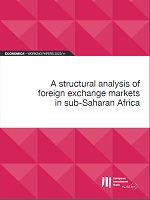EIB Working Paper 2022/11 - A structural analysis of foreign exchange markets in sub-Saharan Africa
| dc.contributor.author | Kaltenbrunner, Annina | |
| dc.contributor.author | European Investment Bank | |
| dc.date.accessioned | 2022-11-18T05:31:00Z | |
| dc.date.available | 2022-11-18T05:31:00Z | |
| dc.date.issued | 2022 | |
| dc.identifier | OCN: 1354535791 | |
| dc.identifier.uri | https://library.oapen.org/handle/20.500.12657/59284 | |
| dc.description.abstract | "Many countries in Sub-Saharan Africa have liberalised their foreign exchange markets and capital accounts, and have moved to more flexible exchange rates, in recent decades. In this context, the interaction between non-resident investors and export structures centred on primary commodities create a risk of destabilising exchange rate dynamics and further complications for macroeconomic management. This paper presents detailed insights into the micro-characteristics of several African Lower and Lower-Middle Income Countries' foreign exchange markets and the implications of these characteristics for macroeconomic management. It draws on interviews with foreign exchange experts in central banks, banks, non-bank financial institutions, and research institutions in Ghana, Kenya, Malawi, Sierra Leone, Uganda, and Zambia, as well as the City of London. The results show that whilst most of these countries have functioning foreign exchange interbank markets, these markets are often characterised by low, volatile and “lumpy” liquidity. These liquidity dynamics and uncertainty about future foreign exchange flows can lead to foreign exchange hoarding by market participants, further depriving the market of liquidity. Those with access to foreign exchange liquidity can gain significant market power and the potential to affect price dynamics, which has meant that central banks in these countries have remained key agents in foreign exchange markets, to manage scarce and volatile liquidity patterns. Overall, the results show the difficulties of moving towards floating exchange rates, for African countries characterised by concentrated export structures, low trust in their currencies, and shallow domestic financial markets." | |
| dc.language | English | |
| dc.rights.uri | Copyright held by content provider | |
| dc.subject.classification | thema EDItEUR::K Economics, Finance, Business and Management::KF Finance and accounting::KFF Finance and the finance industry | en_US |
| dc.subject.other | Business & Economics | |
| dc.subject.other | Finance | |
| dc.subject.other | Financial Engineering | |
| dc.title | EIB Working Paper 2022/11 - A structural analysis of foreign exchange markets in sub-Saharan Africa | |
| dc.type | book | |
| oapen.identifier.doi | 10.2867/598448 | |
| oapen.relation.isPublishedBy | 66479d04-7b84-49c0-9a4d-db552a3ecc71 | |
| oapen.relation.isFundedBy | b818ba9d-2dd9-4fd7-a364-7f305aef7ee9 | |
| oapen.relation.isbn | 9789286153723 | |
| oapen.collection | Knowledge Unlatched (KU) | |
| oapen.imprint | European Investment Bank | |
| oapen.identifier | https://openresearchlibrary.org/viewer/98ec18c5-4838-4eff-b792-6de23a50a66b | |
| oapen.identifier.isbn | 9789286153723 | |
| grantor.number | 98ec18c5-4838-4eff-b792-6de23a50a66b |

